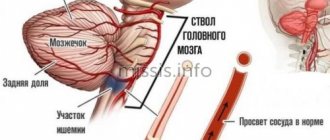Dissociative identity disorder (also called multiple personality disorder or multiple personality disorder) is a mental disorder in which the consciousness does not have a single “I”, but is divided into 2 or more alter egos, which is why laymen often call it a split personality.
The presumable cause of the development of this disease is psychological trauma suffered in childhood . Before making an accurate diagnosis, a conversation is held with the patient and his behavior is observed. Anamnesis plays an important role in examining the patient. Information is collected about the subject's past life. The closest circle of close people is interviewed.
General information
In psychiatry, a special place is occupied by dissociative disorders (Latin dissociare “to separate from the community”), which include dissociative amnesia , dissociative fugue , dissociative stupor , trance and obsession , as well as multiple personality disorder .
Signs that characterize dissociative and conversion disorders (hysterical): partial or complete loss of integration between memory, awareness of personality and control of body movements. Normally, there is conscious control over memory and sensations and at the same time over movements. In dissociative disorders, this control is significantly impaired. The main function of dissociative disorders is to isolate negative experiences. In psychiatry, the term “split personality” is outdated. What is the current name for split personality? The term used is “dissociative identity disorder” or, according to the classification, multiple personality disorder. This type of disorder is characterized by the presence in one person of more than two personalities (these are called alter personalities, or identities), which do not manifest themselves simultaneously. This condition is post-traumatic stress disorder and a way of protecting yourself from the difficulties of real life. Dissociative disorder is the loss of control of the “I” over subpersonalities that are under its control in a normal state.
The disease multiple personality disorder is defined on Wikipedia as a rare mental disorder in which the patient seems to experience a split, a disintegration of the personality as a whole and some part of the whole gets out of control. There is a main principle - separation and alienation. The entire structure is destroyed from the inside. One gets the impression that in one person there are several partial personalities (subpersonalities or alter personalities), which at certain moments replace one another. They are not personalities in the broad sense - they are artificial parts of the personality that help cope with distress.
Wikipedia notes that different identities are expressed to varying degrees, one of the personalities is dominant and both are unaware of each other's existence. Each personality is characterized by its own memory and behavior and does not have access to the memories of the other. The change from one personality to another occurs suddenly and is directly related to events that traumatize the psyche. The transition from one identity to another is possible for various periods - from several minutes to years. Subsequent shifts are also tied to stressful and dramatic events, and also occur during therapeutic sessions of relaxation or hypnosis. The personality that prevails in a given period completely subordinates a person’s behavior, and it is strikingly different from the personality of the owner.
Dissociative identity disorder can appear at any age, from childhood to old age, but is most common in adolescence and young adults. This disorder is more prevalent in women (ratio 1:10). There is evidence that the disorder may be hereditary: close relatives of the patient have a predisposition to this pathology. Perhaps this disorder is not rare, but cases of patients turning to specialists are rare. This disorder is subject to correction. Schizophrenia is also manifested by the presence of multiple personalities, and it is important for psychiatrists to understand and not impose the label of this disease on the patient for life.
Associated conditions
In addition to splitting consciousness, the patient is accompanied by other symptoms:
- rapid mood changes;
- depression;
- increased anxiety;
- sleep disorders;
- eating problems;
- change of tastes, interests;
- talking to yourself in different ways;
- hallucinations – tactile, gustatory, visual.
70% of DID patients commit suicide. However, an indicative diagnostic criterion is dissociative amnesia.
The subject forgets the events of his personal biography and finds it difficult to fully tell the story of his own life. His school activities are marked by sharp declines and increases in academic performance. There is amnesia for current events. For example, the patient is firmly convinced that today is Tuesday, lives on Tuesday, although in fact today is Thursday. He doesn’t remember the events of two days. There is also no opportunity to remember some actions or words spoken.
Patients discover things whose origin is difficult to explain, and incomprehensible notes. Friends ask you to do something (play the guitar), but the person understands that he doesn’t know how to do it. When a passerby nods affably to him as a sign of greeting, it is difficult for the patient to remember who it is.
Depersonalization and derealization are manifested by a feeling of detachment. The patient feels as if he is observing his own life from the outside. He is not able to control his own thoughts and actions. He has a feeling of the unreality of what is happening, individual things seem changed, change outlines, properties. A similar state overtakes the basic personality.
Pathogenesis
How to get split personality? One of the mechanisms by which the psyche tries to cope with stress and uncontrollable memories is dissociation (separation). Trauma affects the child’s psyche, splitting it into several autonomous particles, which become the basis for subpersonalities in the future. Dissociation is activated under appropriate conditions and is of a purely unconscious nature. It plays a protective role and gradually acquires a complex character, and this entails the destruction of the integral structure of the personality.
Dissociation protects the individual from trauma by splitting experiences into parts. Subpersonalities are formed from five to twenty-five years and on average, from 6 to 16 subpersonalities can be formed. The earlier re-traumatization occurs, the greater the risk that dissociative disorder will develop and personalities will be formed. Alter personalities take on a traumatic past, which is why they are formed. The new Alter personality is freed from experiences, a new biography, a new personal history is formed.
Splitting occurs at the unconscious desire of a person as a desire to fence off and isolate from negative memories. But not every alarming event can provoke a “crack.” The trigger (trigger mechanism) must be very serious. The various ego states in an individual's body are changeable and there is one personality - the “master”. It is important to emphasize a feature: the host personality and alter ego suffer from dissociative amnesia if one of them “captures” the person’s consciousness. The remaining parts of consciousness are “inactive.” Sometimes there are cases when one of the parts comes to doctors for help.
According to the second mechanism for the development of dissociations, a child at birth lacks personality integrity, and it is formed under the influence of experience and external factors. Under favorable conditions, the personality is integrated into a single whole, and severe traumas delimit the formation of the personality - two independent personalities arise before and after psychological trauma. Also important for mental evolution is the process of differentiation - thanks to it, the individual “I” of a person is isolated, and multiple partial personalities move into the sphere of the unconscious and function in dreams, in borderline states, in neurotic and psychotic disorders.
About schizophrenia
Schizophrenia is an endogenous polymorphic mental illness that affects thinking. It does not lead to a split personality. Even if the patient considers himself Napoleon, no split occurs. In this case, we are talking about the disintegration of personal characteristics, but within the framework of one identity. As a result, a person can completely lose touch with reality and remain inside his own fantasies.
The causes of schizophrenia are unknown. Like most mental disorders, it is genetically determined. It can be triggered by various factors, including psychological trauma, as with split personality.
Schizophrenia manifests itself in different ways and develops some form in about 1 in 100 people.
The symptoms of psychopathology depend on the phase. When the psyche is active, symptoms of an attack or exacerbation are observed:
- Delusional ideas (delusions of grandeur, delusions of jealousy, invention, reformism, etc.).
- Hallucinations (often voices, but can be visual, tactile or even olfactory).
- Catatonic syndrome (excitement, in which a person makes strange, similar movements; or stupor, when the patient freezes for a long time in an unnatural position).
In the negative phase, the patient suffers from apathy, depression, lack of will and other symptoms that indicate the passivity of the mental apparatus.
These signs can also be observed in people with split personality. However, delusions and hallucinations are extremely rare. Catatonia is also not typical for this disorder.
Treatment of schizophrenia is carried out using psychotherapeutic methods and medications. Among the latter are various types of antipsychotic drugs. Some of them increase dopamine levels, while others, on the contrary, decrease them. This allows you to cope with depression or delusions and hallucinations, respectively.
Classification
Despite the fact that multiple personality disorder is included in the ICD (code F44.81), in a number of countries doctors deny the existence of this disease. There are blind spots, riddles, questions and secrets in this issue. All researchers argue about the reality or falsity of the disease. How does a person have multiple personalities? Perhaps this is just a fantasy, and not a disease? Indeed, there are individuals who react this way to unpleasant events in their lives. Perhaps this is the activation of personalities of previous incarnations, who have their own experience, characteristics of consciousness and their own history?
Since this problem is dealt with by psychoanalysts, psychologists, and psychotherapists who are not experts in psychopathology, it is difficult to draw statistical conclusions from their descriptions. There are only 350 case reports with a diagnosis according to ICD-10 F.44.81. It is impossible to deny the possibility of this phenomenon being suggested by psychologists and psychotherapists and of their cultivation of this phenomenon.
The topic often appears in feature films, but almost all cases of split personality described are related to crimes, forensic psychiatric examinations and escaping punishment. In forensic psychiatric practice, this is most often a simulation. Films about multiple personality disorder: “The Three Faces of Eve”, “Duplicate” (2018, USA), “Black Swan” (2010, USA), “Mrs. Hyde” (France 2017), “Me, Myself and Irene” (2000, USA), “Dark Mirror” (2018, USA), “Frankie and Alice” (2009, Canada), “Hide and Seek” (2005, USA), “Split” (2016, USA). Examples of split personality are shown to us in fiction and documentary works - books by Trudy Chase “When the Rabbit Howls”, Flora Schreiber “Sibyl”, Anastasia Novykh “AllatRa”, Crabtree “Multiple Man”, Daniel Keyes “The Multiple Minds of Billy Milligan” and “The Mysterious Case of Billy Milligan."
The last two are documentary: the real patient Billy Milligan tells the author about his subpersonalities in an interview, the author’s conversations with the doctors who examined and treated this patient are recorded. Disintegrated Billy's adaptive capabilities increased, despite the fact that there were internal conflicts and struggle between individual subpersonalities. Integrated Billy lost significantly in general adaptive abilities. The Billy Milligan case set a precedent for exoneration of criminal liability for those who committed a crime due to multiple personality disorder. This fact clearly demonstrates the attitude that it is more profitable to be a split personality than to be a holistic one.
In the West, this disorder is not considered a disease, but is considered as a variant of the norm. If the state of multiple personality is not uncomfortable for a person and does not cause social consequences, then it cannot be treated, and many patients refuse to integrate subpersonalities into a single whole and do not seek help.
Videos from psychologists and psychiatrists will be more useful: “Split Personality” by Veronika Stepanova, “Dissociative Identity Disorder” by Evgeniy Chibikov. At the same time, many psychiatrists admit that in all their practical activities they have never encountered such patients. Still, it is believed that with multiple personality there is a predisposition to this from birth and the ability to self-hypnosis. Most often, a child is emotionally abandoned, and he finds an imaginary friend and mentally turns into him (a horse, a spider-man) - a defense mechanism against loneliness is triggered (now there are two of us, and we are not bored or scared). Severe psychological trauma in childhood (usually of a sexual nature) contributes to the emergence of alternative personalities - saviors, guardian angels, or evil and aggressive ones.
People with a split personality are sometimes critical of themselves and describe their condition as follows: “I see another personality, but it takes over me, it sucks me in, and I cannot control this process.” These selves are different and have different qualities, inclinations and abilities. A person with a split personality often goes on social networks and these subpersonalities “write” under different names and describe pictures from their lives. They have different gender, age, nationality, writing style and presentation of thoughts.
Many psychiatrists are not inclined to identify this disorder as an independent nosology and consider it as a manifestation of a hysterical disorder. To raise a hysterical child, you need to create an idol out of him; he is allowed everything, he is surrounded by attention, but as an adult he does not receive such attention and does everything to attract him to himself. According to many authors, hysterical psychosis is a psychogenically caused, functional disorder, and not an organic one.
Hysterical (dissociative) psychoses are heterogeneous in clinical manifestations. Hysterical psychoses include: hysterical twilight stupefaction , puerilism , pseudodementia , personality regression syndrome , hysterical stupor . Depending on the severity, the picture of psychosis can combine various hysterical disorders, or some hysterical manifestations can be successively transformed into others. These psychogenic reactions are formed against the background of situations of loss (death of relatives, breakup of relationships) and are interpreted as a “repression reaction” of mental trauma.
Puerilism, considered as hysterical psychosis, is manifested by a hysterical narrowing of consciousness and childish behavior in adults. Childish speech, movements, behavior, and emotional reactions are typical. Patients lisp, speak in childish intonations, play with dolls, run in small steps, pout their lips in response to insult or stomp their feet, and promise to “behave well.” In general, there is a return of psychological functioning to the childhood level caused by mental disorders (stress, schizophrenia).
This disorder can be a temporary phenomenon (with stress) or persistent and irreversible (intellectual regression in schizophrenia in adults). Unlike foolishness in schizophrenia, symptoms in puerilism are more changeable, varied and have a strong emotional overtones. Symptoms of puerilism are combined with other hysterical manifestations.
Factors in the development of the disease
Determining an exact list of reasons that contribute to the formation of multiple personalities is not easy, since the situation varies. A larger percentage of people suffering from the disease had the same causes.
Childhood shocks provide the necessary impetus for the development of the disorder. Such shocks are characterized by severe emotional stress. In some cases, the cause is violence. In addition to the above, deviations arise due to abundant mental stress caused by the environment. The presence of physical impact is not decisive.
Family violence
Experts characterize split personality as a defense of the human psyche. The result of this defense is isolation from traumatic memories. This leads to the formation of an alternative personality.
Primary school children are most vulnerable to developing the disease . At this stage, the development of the sensory components of the growing organism occurs. The disorder occurs as a result of a mental disorder. Adults are less susceptible to such effects.
According to unofficial information, in psychiatry departments there are 3% of patients diagnosed with multiple personality disorder. Studies have shown that the predisposition of women is higher than that of men. However, the statistics are not accurate, since it is more difficult to identify mental problems in men.
Causes
Causes of multiple personality syndrome:
- mental trauma due to physical, sexual or emotional abuse suffered before the age of five;
- stress (for example, separation from mother);
- shocks;
- shock trauma.
Patients with dissociative disorder often experience prolonged and severe abuse and neglect during their childhood years. Some patients were not exposed to violence, but had strong experiences. Children who have experienced abuse or stress do not integrate their memories and life experiences and remain separated. And children develop an adaptive ability (withdrawal, separation from the harsh environment, “detachment”), which protects the psyche. Each negative experience experienced can provoke the development of a new personality, resulting in the formation of multiple personality.
But not every child reacts to violence this way. Only an easily suggestible person with hysterical tendencies is capable of dissociative response mechanisms. These are demonstrative people, prone to theatricality, wanting to be the center of attention and loving to impress others. People with this disorder are highly sensitive to hypnosis. Another predisposing factor is organic pathology of the nervous system (abnormalities in the encephalogram).
How to detect identity substitution in time?
During a person's transition from one state, a brief fainting may occur. This is an instant action that goes unnoticed by the people around him. Even the patient can ignore this and live quietly in a similar situation for several years. In this case, medical assistance is necessary!
Split personality has a direct connection with the brain. With the processes that take place in it. But they have not been studied. Doctors cannot give an exact definition and answer to the phenomenon. It can be diagnosed and treated for multiple personality disorder for years, but there is no guarantee that a person will be able to overcome the disease completely. We can only guess about the origin of this process. There is an assumption that otherworldly forces were involved here...
Split Personality: Symptoms and Signs
Only a highly qualified specialist can make an accurate diagnosis by analyzing the signs of split personality. Signs such as imbalance, poor sleep, memory loss, and mood swings are not noticeable to the patient himself, but the doctor takes them into account. If the patient “switches” from one ego state to another, and at this time the heart rate and breathing rhythm change and become characteristic of the “newly emerging” personality. This also does not escape the attention of the doctor.
Symptoms of dual personality appear in different forms:
- In the obsessive form, the personality is noticeable to others. Patients act in a way that is unusual for them - another person has moved into them.
- In the non-possessed form, subpersonalities are not obvious to other people, but patients experience a feeling of “remoteness” from themselves, the unreality of what is happening to them, detachment in relation to the physical and mental processes occurring with them. The patient feels like observers of their own life from the outside and have no power over it or the ability to change anything (there is a loss of self-organization). It may feel like the body does not belong to oneself or feel like a small child or person of the opposite sex. Patients suddenly develop thoughts and emotions that are not typical for them, and these manifestations are noticeable to relatives and friends. At the same time, preferences in food, clothing, or their interests may change. Moreover, preferences suddenly change and return to their previous state. Such patients are faced with intrusions of subpersonalities into everyday life: at work, an angry and unkind personality suddenly makes them shout at a co-worker or boss.
The second important symptom is amnesia, which manifests itself:
- gaps in memory regarding events of personal life and biography;
- failures in stable memory (a person loses well-mastered computer user skills);
- discovering that he does not remember what was done or said.
Some periods of time disappear completely from memory because amnesia occurs between individuals. The patient may find objects in a bag or note, but cannot determine their origin. Patients find themselves in places with no memory of how or why they got there. Patients forget both everyday and stressful events. The degree of awareness of their amnesia varies and some try to hide it. Their amnesia is noticeable to others because they cannot remember what they said, promised or did. Some people forget their name.
Subpersonalities coexist with each other: they may or may not conflict with each other and with the main personality. Non-conflict coexistence is mild, does not cause changes, and the patient does not consult a doctor.
With conflict coexistence, the patient experiences anxiety , depression , bulimia , anorexia , substance abuse , and suicidal behavior . Patients may hear voices and experience visual, olfactory, tactile, and taste hallucinations. But these hallucinogenic symptoms are not the same as those seen in schizophrenia. Patients perceive these voices as voices of an alternative personality.
Switching between them is manifested in a change in voice and facial expression. Periodically, the patient refers to himself in the third person or plural. Switching between personalities leads to a chaotic life for the patient. These symptoms cause significant discomfort or interfere with social and professional activities.
Types of DID
There are two forms of the disease: non-possessed and possessed.
The non-possessed form is manifested by minor external changes in the patient, sometimes unnoticeable to others. The patients themselves characterize their own condition with the following sensations:
- they contemplate their own lives as outside observers, unable to intervene in the course of events;
- feel detached from their own physical and mental state;
- feel bodily changes - consider themselves old, too young, a person of the opposite sex;
- talk about the unreality of what is happening;
- They notice the influx of an endless stream of thoughts, they notice previously alien emotions.
Hints of the presence of a disorder can appear in individual details. For example, a person suddenly changed his image and is interested in things that were previously insignificant to him. Eating habits and emotional characteristics change. For example, a previously balanced individual is now characterized by short temper, nervousness, and anger.
The possessed form is characterized by a sharp change in behavior, noticeable to all people who know him. The patient is called by someone else's name, actions become different from the usual. The patient represents a new person or being. Often patients are presented as God, a demon, an angel. The split ego explains the previously existing concept of “possessed by the devil.” Shamans are considered the first representatives of dissociative disorder. Drawings from the Paleolithic period were found confirming the reincarnation of sorcerers into animals and the infusion of spirits.
Perhaps the most famous multifaceted personality is Billy Milligan. 24 autonomous ego states coexisted in it simultaneously, 10 of which were basic. Billy was considered the main one. Arthur and Ragen Vadaskovinich are also interesting.
Arthur is a 22-year-old Englishman, highly intelligent, educated, and mannered. In the scientific and medical field - a high specialist. Rejects the existence of God, wears glasses, smokes. It was he, guided by the deductive method, who discovered the presence of other subpersonalities and developed general rules of behavior.
Ragen Vadaskovinich is a native of Yugoslavia, 23 years old. Called the "guardian of hatred." Extremely strong, distinguishes all types of weapons. He treats women and children with special respect and always helps them. A large, strong guy, along with Arthur, controls the overall body, regulating dangerous situations.
In addition to the previous guys, among the 10 main identities are an 18-year-old eloquent scammer, a 14-year-old boy, Danny, who is afraid of men, and 3-year-old Christine, who appeared first among the rest of the Ego States. The girl stood behind Billy in the corner when he did something wrong, Ragen's favorite.
There was also Christine’s brother Christopher, lesbian Adalana, little David who accepts pain, Tommy’s keeper of salvation, helping to get out of limiting circumstances. For example, he knows how to remove handcuffs.
The remaining 13 subpersonalities were declared undesirable by Arthur and Ragen for inappropriate, antisocial behavior. For example, Phil and Kevin organizing armed attacks. It was for them that the “real” Billy was tried, as well as for the rapes committed by the lesbian Adalana due to a lack of love, warmth and the need for hugs.
Billy Milligan is famous for being accused of robbery and rape, but acquitted. The man became the first defendant acquitted of the diagnosis of “Multiple Personality.” Lawyers were able to prove that several of Billy's alternate identities were guilty of crimes. He was sent to a psychiatric hospital to receive treatment until he fully recovered. After 10 years, Billy was cured and released from the hospital.
The cause of Billy Milligan's disorder is believed to be a difficult childhood. The boy's father suffered from alcoholism, depression, and committed suicide when the boy was 6 years old. Eight-year-old Billy's stepfather tied up and raped the boy in a barn. The moment when a guy’s first new identity emerges is considered to be a period of 3-4 years.
Subsequently, the story of Billy Milligan was outlined in his novel by Daniel Keyes, calling his work “The Many Minds of Billy Milligan.”
Tests and diagnostics
Diagnosis of this condition is difficult. It is based on anamnesis, questioning, and sometimes in combination with hypnosis.
The main diagnostic signs are taken into account:
- The existence of two or more personalities and only one can seize control over a person at a certain point in time.
- The presence of individual characteristics, preferences and memories in subpersonalities.
- A person forgets important information, but this is not associated with ordinary forgetfulness.
- The above symptoms are not a consequence of organic damage to the central nervous system and the use of psychoactive substances.
When making a diagnosis, the connection between the occurrence of symptoms and the use of drugs and alcohol is excluded. Children often display imagination and play with imaginary friends. Long and repeated interviews are recommended to be carried out under the influence of hypnosis or medications (amytal-caffeine disinhibition), and between doses, patients should keep a diary, which is then reviewed and analyzed by the doctor. Drug disinhibition has diagnostic significance: in a person, under the influence of medications, subcortical structures are disinhibited. While in a relaxed state, the patient reports information that was inaccessible due to psychogenic amnesia, repression, and conscious concealment.
In a state of hypnosis, the doctor gains access to other personalities and tries to establish direct contact with them. Over time, the clinician can map out the personalities as well as their relationships. This helps the patient better control dissociated states. The doctor also takes into account the possibility of simulation for personal gain (evading responsibility and punishment).
Patients are asked to take a test for dissociative identity disorder, which includes easy questions that anyone can answer. There are a lot of tests developed and you can pass them all. It is advisable for people whose relatives have had such disorders to take the online split personality test. Knowing the existing problem makes it possible to prevent it by working with a psychologist.
What to do if a person refuses treatment?
You need to understand why he does this. It may take time to talk about the problem. Try to explain that there are no difficulties in the course of treatment and you will easily go through the path together. You shouldn’t tell scary stories, but you don’t need to lie that you’ll be cured in a month.
You can call a doctor yourself, without permission. You need to write a statement that will be the reason for the home inspection. If the doctor sees that the patient’s condition does not have symptoms that threaten his life and those around him, he is asked to sign papers for the course of treatment, but you have the right to refuse. Involuntary hospitalization is possible when a person is in a complex psychological disorder, and his actions can harm loved ones.
Prevention
Because dissociative identity disorder is a mental illness, there are no preventive measures. But since the main cause is child abuse, it is important to avoid traumatic situations in childhood. International organizations and social services are working to identify and eliminate violence. If severe stress and psychological trauma have occurred in a child, it is important to contact a specialist in a timely manner, which will prevent the development of dissociative disorders in the future.
Symptoms of the disorder
Sociopathy can manifest itself already in early preschool and adolescence; symptoms of the disorder in boys usually become visible already in early school age. In girls, symptoms appear a little later - during prepuberty. The symptoms of the disorder are numerous: the child is selfish, hostile, stubborn, cruel (does evil to peers, tortures animals, skips classes, runs away from home, damages property, steals). When communicating with people, he is angry, quick-tempered, and attacks of rage are possible. Has a very high opinion of himself. A distinctive feature of patients with dissocial personality disorder is early opposition to parents. Due to the lack of attachment to others and a critical assessment of their actions, they neglect family traditions, moral and legal norms.
A person can deceive, speculate or manipulate other people for his own purposes, using his intellectual abilities for this. In order to get what they want, they are extremely charming, talkative, and endearing. They constantly crave easy entertainment and pleasure, an idle lifestyle, and try to avoid any work, study, or fulfilling any duties. Since adolescence, they have been drawn to antisocial companies, alcohol, and drugs. They are indifferent to their future and live in the present. They are weak-willed and cowardly - they try to run away from any difficulties and troubles.
Patients with antisocial personality disorder may rationalize their actions by blaming those they have offended, saying that they are to blame or deserve such treatment. They do not feel remorse or remorse, they are always confident that they are right, and at any cost they do what they consider best for themselves at the expense of other people. They are guided not only by selfish interests, but also by the desire to annoy and offend others. Any recovery from them is regarded as a manifestation of injustice.
In adulthood, a person with a similar disorder most often looks adequate and socially adapted. There are no problems in communication - thanks to their charm and ability to win over others, they often make a pleasant impression during superficial contacts. Sociopaths have a special magnetic power, and people who need to be nurtured and guided enjoy being around such a “strong” person. This calms them down and gives them confidence. A person with sociopathy is often sexually attractive, which he takes advantage of. Sexual life is a source of pleasure. Such a person is not able to love, empathize, sympathize, but can imitate love. you will never suspect that he does not feel anything for you.
A person with dissocial disorder is a desperate arguer who always wins, and if they try to catch him, he will dodge to the end, but will not admit to being wrong or lying and will most likely launch a counterattack. When trying to argue the accusations and his wrongness, the sociopath will respond with accusations that they want to denigrate his honor. There is no point in competing with such a person; in any situation, it is important for him to always win, and he will use any means to achieve this.
As a result of their impulsiveness, patients do not plan in advance, are socially and financially irresponsible - they handle money carelessly, often move, change their place of residence, work, and relationships. They may not pay bills, loans, alimony. Very often, sociopaths end up in prison; for many people with this disorder, criminal behavior begins to decrease after 40 years. Abuse alcohol and psychoactive substances. In a state of intoxication, conflict and aggressiveness increases.
Dissocial personality disorder persists throughout life; treatment is ineffective, but it helps to slightly correct behavior. Some patients create social groups isolated from society, becoming leaders of sects or criminal groups. With age, many patients develop concomitant affective and somatization disorders, alcoholism, and drug addiction.
Forecast
In terms of prognosis, it can be noted: the earlier the disorder begins, the worse the prognosis for a person in social terms. Recovery is most often not complete. Impairments in dissociative identity disorder vary widely, from mild to severe. Treatment can reduce social, occupational, and relationship problems. Some patients respond slowly to treatment and require long-term treatment.
In this regard, patients are divided into groups:
- Patients whose symptoms are dissociative and post-traumatic in nature. Such patients retain their legal capacity and fully recover during treatment.
- Patients who, in addition to dissociative symptoms, also have other disorders: eating behavior, affective disorders, personality disorders, substance abuse disorders. Treatment in such patients is less effective, and improvement occurs slowly.
In both groups there are symptoms of mental disorders (emotional attachment to offenders). In this connection, it is necessary to carry out a longer course aimed not only at achieving personal integrity, but also at eliminating the symptoms of mental disorders. Dissociative identity disorder, compared to other personality disorders, is the most severe and has a chronic course. This is due to the fact that each alter personality may have its own mental disorders.
Treatment
Treatment of dissociative identity disorder is carried out with the help of psychotherapy - cognitive, family, behavioral, etc. All of them are aimed at merging all personalities into one full-fledged identity. The psychiatrist also tries to identify the nature of the internal conflict, to work through situations that turned out to be traumatic for a person and became the reason for the creation of many personalities.
Drug therapy for such diseases does not help. There are no specific medications designed to treat it. The doctor can only prescribe antidepressants if the patient is worried about anxiety and depression. But the main treatment is aimed at ensuring the harmonious coexistence of different personalities. This allows you to protect both the patient and those around him.
List of sources
- Brushlinsky A.V. Psychology of the subject. M., 2003. 272
- Korolenko T.P., Dmitrieva N.V., Zagoruiko E.N. Identity in normal and pathological conditions. Novosibirsk, 2000. 255 p.
- Turbina E.G. Multiple personality syndrome // Kemerov V.E., Kerimov T.Kh. (ed.) Social philosophy. Ekaterinburg, 2006. P. 205
- Nikiforova P. The phenomenon of multiple personality in science and culture. St. Petersburg, 2014. 20 p.
- Putnam Frank W. Diagnosis and treatment of multiple personality disorder. Per. from English - M.: Cogito-Center, 2004. - P. 10, 138-150.
Patients with schizophrenia are dangerous to others
In most cases no. There is a widespread belief that among murderers and rapists a large number of people suffer from schizophrenia. According to statistics, there are very few patients with this disorder among those who attack people. Typically, aggression towards other people is not a standard symptom of schizophrenia. In some cases, patients may have persecutory delusions, in which case they may be dangerous to the objects of their delusions. However, such situations are rare and do not apply to everyone around the patient with schizophrenia.
Medicines for schizophrenia turn a person into a “zombie”
This occurs if the patient is prescribed treatment with first generation drugs. The drugs “Haloperidol” and “Triftazine” are drugs from the times of Soviet punitive psychiatry. On the one hand, they are quite effective - they relieve psychosis and in some cases they are prescribed even in the most developed countries. The problem is that these drugs cause a huge number of side effects. They reduce activity, lower mood and can seriously affect a person’s emotional state. However, in many cases, taking such drugs is the only possible solution to relieve the active symptoms of schizophrenia, such as psychosis and hallucinations.
Fighting schizophrenia is useless
This is wrong. Thanks to modern medications and psychotherapeutic tools, schizophrenia can be effectively treated. To begin with, it is very important that the patient realizes that he has a disease and is convinced of the need for treatment. Next, the specialist helps the patient learn to recognize the symptoms of the disorder, control their behavior and communication with loved ones in order to prevent exacerbation. Drug treatment allows the patient to lead a normal daily life. Modern medications must be prescribed in such a way that side effects are kept to a minimum. In each case, they are selected individually, taking into account the characteristics of the patient and his condition.
People diagnosed with schizophrenia cannot lead normal life activities
This is wrong. As soon as specialists manage to relieve the active symptoms of the disease, delusions, hallucinations, and as soon as the patient begins to undergo psychotherapy, he gradually returns to almost the same social life that he led before the development of schizophrenia. The patient begins to study, work, start a family and live an almost full life in society. In countries where psychotherapy is carried out insufficiently high quality, and the emphasis is mainly on drug treatment and relief of psychosis, sometimes there is no attempt to return people to normal life. With effective treatment and the patient’s desire to be cured, he is always returned to life in society, regardless of the severity of the initial symptoms.
The main reason for the development of schizophrenia is genetic predisposition
Yes, schizophrenia is a genetic disease. Which genes are responsible for the development of this disorder is currently unknown to science. In order for a genetically determined disease to start, some external trigger must arise. Some people will develop schizophrenia due to an external trigger, while others will develop, for example, bipolar disorder or depression. It depends on what a person is initially predisposed to. The most common trigger for the development of schizophrenia is psychological trauma. It can be very subjective. For example, for some, a transition to another school, illness, death of a loved one, or divorce may be a trauma, but for others, all of these are not severe traumatic events and will not affect the development of a genetically determined disease.









